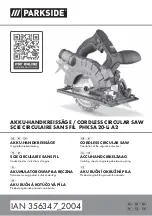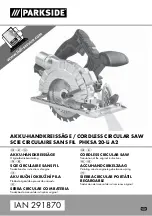
32
Plug the machine into the power. Turn the machine on for a second and switch off.
Watch how the blade runs. If the blade tracks well, then run the machine at full
power. If the blade tracking needs adjustment, repeat adjustment.
Tension the blade as described in method 1.
Close all the doors and ensure that all the guards are fitted.
Start the band saw and look at the blade from the front of the machine. Start to
detension the blade very slowly until the blade starts to flutter (wobble from side to
side). Then start to tension the blade until the blade stops fluttering and is running
true. Increase the tension on the blade by one complete turn on the tension handle.
You may find that each size and type of blade will need more or less additional
tension. For example, a 1/16" blade will need less additional tension than a 3/4"
blade. Again, experience is the key, and with a little practice it will become second
nature.
The key to all tensioning is to get the blade to cut straight and true with the minimum
amount of tension. The less tension that you put on the blade, the longer the blade
and the machine will last.
Note.
The upper flywheel has a spring that is used to keep a constant pressure on
the blade during use. As the blade cuts, heat is generated, which causes the blade
length to expand. The spring compensates for the change in length, and you must
never bottom out the spring while tensioning the blade.
Note.
If you are not using the bandsaw for extended periods of time (overnight),
remove the tension on the blade. This will increase the life of your blade and the
machine. If tension is left on the machine, flats or grooves can be formed in the
rubber of the wheels, which will detract from the performance of the machine and in
extreme cases cause vibration. Removing the tension will greatly enhance the life of
the machine, bearings and tires.
Label the machine “
detensioned.
” On the label mark the
number of turns that you
detensioned; this way you will know how many turns that you have to put back on to
have your blade correctly tensioned.
.
1.
Disconnect the power to the bandsaw.
2.
Remove the table split clamp that aligns the two table halves.
3.
Remove all the guards.
4.
Remove the table insert.
5.
Remove the tension on the upper flywheel.
6.
Open the doors and remove the blade from the wheels (use gloves and eye
protection) and gently slide the blade through the table slot.
Removing the blade from the bandsaw
Method 2
Summary of Contents for 14-Twelve Bandsaw
Page 53: ...53 Electrical Drawing...
Page 54: ...54 Industrial Work Light Optional Exploded View Drawings and Parts List...
Page 55: ...55 Lower Wheel And Motor Assembly...
Page 56: ...56 Stand Assembly...
Page 57: ...57 Table and Fence Assembly...
Page 58: ...58 Upper and Lower Blade Guides Assembly...
Page 59: ...59 Upper Wheel Assembly...
Page 60: ...60 Wheel System Optional...
















































